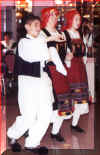Orpheus Hellenic Folklore Society Newsletter
| Orpheus Celebrates End of the Year Bash |
 After a full
day of performing at the Skokie Festival of Cultures, the Orpheus family gathered together
that evening at the Golden Flame Banquet Hall to continue the festivities into the night
with good food, music, and filoxenia! The event was organized by the Orpheus Youth Group
parents to celebrate the end of the year and provide an opportunity for all Orpheus
members and their families to come together in a relaxed atmosphere and dance, dance,
dance! Members of the Youth Group arrived at the hall still dressed in costume from the
earlier performance, and excitedly made last minute preparations with their instructors
before giving their families a tremendous performance. The group was all smiles as they
"showed their stuff" with pride and a great deal of poise and enthusiasm. Amid
loud applause and encouraging shouts of "Opa", the boys' rendition of Tsamikos
brought down the house. Afterwards, Youth member Tom Mihalopoulos commented, "This
was one of our best performances, and it was so much fun to dance for our relatives!"
Patricia Minakakis agreed, "I can't believe I'm having so much fun, and we were so
relaxed out there - but when can I change out of my costume?" The evening continued
with delicious food and sweets provided by the Youth Group families, and then DJ Dino
Dallas took over - and the serious dancing began. Once again, the Youth Group dancers took
to the floor, and were soon joined by their parents and siblings, as well as members of
the senior Orpheus Group, and in no time the floor was rocking with various Syrta and
Tsamika. The young dancers requested certain songs and members of the Youth and senior
group joined together for Orpheus dances such as Pentozalis and Issios. The dancing
continued well into the night, and it was great to see young and old dancers enjoying
themselves, and especially to see the youngsters celebrating their dance heritage. Many
thanks to Barbara and Dino Dallas, Alexandra Pontikes, the Golden Flame Banquet Hall, and
all the participating Orpheus members and families who helped make this evening a huge
success. After a full
day of performing at the Skokie Festival of Cultures, the Orpheus family gathered together
that evening at the Golden Flame Banquet Hall to continue the festivities into the night
with good food, music, and filoxenia! The event was organized by the Orpheus Youth Group
parents to celebrate the end of the year and provide an opportunity for all Orpheus
members and their families to come together in a relaxed atmosphere and dance, dance,
dance! Members of the Youth Group arrived at the hall still dressed in costume from the
earlier performance, and excitedly made last minute preparations with their instructors
before giving their families a tremendous performance. The group was all smiles as they
"showed their stuff" with pride and a great deal of poise and enthusiasm. Amid
loud applause and encouraging shouts of "Opa", the boys' rendition of Tsamikos
brought down the house. Afterwards, Youth member Tom Mihalopoulos commented, "This
was one of our best performances, and it was so much fun to dance for our relatives!"
Patricia Minakakis agreed, "I can't believe I'm having so much fun, and we were so
relaxed out there - but when can I change out of my costume?" The evening continued
with delicious food and sweets provided by the Youth Group families, and then DJ Dino
Dallas took over - and the serious dancing began. Once again, the Youth Group dancers took
to the floor, and were soon joined by their parents and siblings, as well as members of
the senior Orpheus Group, and in no time the floor was rocking with various Syrta and
Tsamika. The young dancers requested certain songs and members of the Youth and senior
group joined together for Orpheus dances such as Pentozalis and Issios. The dancing
continued well into the night, and it was great to see young and old dancers enjoying
themselves, and especially to see the youngsters celebrating their dance heritage. Many
thanks to Barbara and Dino Dallas, Alexandra Pontikes, the Golden Flame Banquet Hall, and
all the participating Orpheus members and families who helped make this evening a huge
success. |
| Letters - May 31, 2000 |
 Dear OHFS: Dear OHFS: On behalf of the Skokie
Festival of Cultures Planning Committee, I would like to thank you for your wonderful
performance at our Tenth Anniversary Skokie Festival of Cultures. With the terrific
response and positive feedback we received from our audience, we congratulate you on being
a part of such a successful festival that united cultures from one end of the world to the
other. It was a pleasure working with you and (we) look forward to future performances! |
| Top 10 List |
 Top Ten
Ways To Tell If You Are An Orpheus Dancer Top Ten
Ways To Tell If You Are An Orpheus DancerFrom the home office in Moustoukoulouro, Greece |
|
| Hara Deligiannis Returns This Summer! |
 Once again, Orpheus is pleased to welcome Hara Deligiannis as
guest instructor this summer. Hara has been a member and instructor with the renowned
Lyceum of Ellinidon of Athens for the last twenty years and is currently the director of
the Spata chapter. Hara is making her second sojourn to Chicago this July to spend time
with the OHFS. This year, she will be teaching both the Orpheus adult and Youth Groups,
and we are all excited at the opportunity to learn from her expertise again and expand the
OHFS repertoire of dances. Hara's son, Rafael, has been in Chicago for a couple of weeks
and has already attended Saturday practices with the Youth Group and performed with
Orpheus. A heartfelt thanks to Mrs. Joanne Vadevoulis and La Francaise Bakery for
sponsoring Hara's trip to Chicago. Once again, Orpheus is pleased to welcome Hara Deligiannis as
guest instructor this summer. Hara has been a member and instructor with the renowned
Lyceum of Ellinidon of Athens for the last twenty years and is currently the director of
the Spata chapter. Hara is making her second sojourn to Chicago this July to spend time
with the OHFS. This year, she will be teaching both the Orpheus adult and Youth Groups,
and we are all excited at the opportunity to learn from her expertise again and expand the
OHFS repertoire of dances. Hara's son, Rafael, has been in Chicago for a couple of weeks
and has already attended Saturday practices with the Youth Group and performed with
Orpheus. A heartfelt thanks to Mrs. Joanne Vadevoulis and La Francaise Bakery for
sponsoring Hara's trip to Chicago. |
| OHFS Mans the
Phones Again at Channel 11 |
 A team of Orpheus
members and friends dressed up for a familiar occasion: a pledge drive at the studios of
WTTW-TV, Channel 11. The show featured the program "Greek Americans II - Passing the
Torch", a documentary that examines the struggles and successes of Greek immigrants
and the generations that followed them in the United States. Among the personalities
featured were Michael Dukakis, actress Melina Kanakarides, Wendy's restaurant CEO Dave
Thomas and many others. A team of Orpheus
members and friends dressed up for a familiar occasion: a pledge drive at the studios of
WTTW-TV, Channel 11. The show featured the program "Greek Americans II - Passing the
Torch", a documentary that examines the struggles and successes of Greek immigrants
and the generations that followed them in the United States. Among the personalities
featured were Michael Dukakis, actress Melina Kanakarides, Wendy's restaurant CEO Dave
Thomas and many others.This is the second time that members of the Orpheus Dance Troupe have volunteered their services in manning the phones during a Channel 11 pledge drive. Without a doubt, the presence of the colorful costumes on the set added another dimension and helped to persuade viewers to make that all-important phone call! Indeed, the fundraising effort was a successful one, as the monetary goal for the evening was easily surpassed. As was the case last time when the same documentary was featured, many of the callers were of Greek origin, and in addition to their pledge, they also wanted to purchase a video copy of the documentary to pass it along to their children or grandchildren. Many thanks to all the participants who offered their telemarketing talents on a Thursday dance practice night. Special thanks to Voula Drougas, an OHFS member and Channel 11 employee, who doubled up as a producer for that night and made sure that everyone felt comfortable and welcome. |
| Orpheus Returns to Saginaw, Michigan |
 The
weekend of Father's Day found a team of Orpheus members performing at the St. Demetrios
Church Greek Festival in Saginaw, Michigan, a destination more than 300 miles from
Chicago. The dancers were met by the local community with a warm and enthusiastic welcome,
which helped make the OHFS visit a very pleasant and fun experience. This is the second
year in a row that the Orpheus Dance Troupe has performed for the popular three-day
festival, which draws several thousand guests every night! This year, the schedule
included six performances that featured both mainland and island dance programs with
separate sets of costumes. All presentations were received enthusiastically and much
praise is due to all participating members for their endurance, good spirit and commitment
in putting forward their best effort during this arduous schedule. The weather cooperated
fully with sunny skies and cool temperatures that helped bring out the crowds. The
festival committee and volunteers have to be commended for their excellent organization
and set-up of the festival grounds as well as their tasty homemade food and treats! Apart
from the Orpheus Dance Troupe, the church's dance group, consisting of four different
groups of children of various ages, provided continuous entertainment, along with a Greek
band. As the Orpheus members were departing for the trip home, the local community had
already extended an invitation to return for next year's festival! We will make every
effort to be there! The
weekend of Father's Day found a team of Orpheus members performing at the St. Demetrios
Church Greek Festival in Saginaw, Michigan, a destination more than 300 miles from
Chicago. The dancers were met by the local community with a warm and enthusiastic welcome,
which helped make the OHFS visit a very pleasant and fun experience. This is the second
year in a row that the Orpheus Dance Troupe has performed for the popular three-day
festival, which draws several thousand guests every night! This year, the schedule
included six performances that featured both mainland and island dance programs with
separate sets of costumes. All presentations were received enthusiastically and much
praise is due to all participating members for their endurance, good spirit and commitment
in putting forward their best effort during this arduous schedule. The weather cooperated
fully with sunny skies and cool temperatures that helped bring out the crowds. The
festival committee and volunteers have to be commended for their excellent organization
and set-up of the festival grounds as well as their tasty homemade food and treats! Apart
from the Orpheus Dance Troupe, the church's dance group, consisting of four different
groups of children of various ages, provided continuous entertainment, along with a Greek
band. As the Orpheus members were departing for the trip home, the local community had
already extended an invitation to return for next year's festival! We will make every
effort to be there! |
| Orpheus would like to welcome Janine Weiss-Northcutt who joined the adult group and to new summer youth members Christina Dallas, Penny Kokkinias, Chris Kontos, Vanessa Markopoulos, George Soukoulis, George Tselos, and Elianna Tselos. Welcome! |
| Congratulations to Eftychia Gouvas and Rafael Pantazis for their first performance with Orpheus. |
 Happy Birthday to George Tselos
June 3; Penny Kokkinias June 12; George Soukoulis June
23; Jim Thanopoulos July 3; Kathy Tomaras July 14; Lexia
Vadevoulis July 16; Tasso Giannopoulos July 22; Katerina
Skondos July 24; Hercules Logothetis July 30; Alexis
Arvanitis August 1; Christina Kakavas August 15; Melpo
Katsaros August 21; Elianna Tselos August 23; Genevieve
Theodorakakis August 25; Maria Karras August 27; Alexander
Kapotas September 29. Na ta ekatostisete! Happy Birthday to George Tselos
June 3; Penny Kokkinias June 12; George Soukoulis June
23; Jim Thanopoulos July 3; Kathy Tomaras July 14; Lexia
Vadevoulis July 16; Tasso Giannopoulos July 22; Katerina
Skondos July 24; Hercules Logothetis July 30; Alexis
Arvanitis August 1; Christina Kakavas August 15; Melpo
Katsaros August 21; Elianna Tselos August 23; Genevieve
Theodorakakis August 25; Maria Karras August 27; Alexander
Kapotas September 29. Na ta ekatostisete! |
| Nameday Greetings to Marianna Damianides, Marianna Kaltsa, Maria Kakleas, Maria Karras, Patty Pappas, Patty Panagakis, Pat Tomaras, and Peter Panagakis on August 15th; Alexander Kapotas on August 30th; Sophia Sianis, Sophia Tsipianitis, and Sophia Prassas on September 17th. Chronia Polla! |
 Congratulations
to Christina Kakavas who landed a new job as a graphic designer at Slack
Barshinger & Partners. Good Luck! Congratulations
to Christina Kakavas who landed a new job as a graphic designer at Slack
Barshinger & Partners. Good Luck! |
| Orpheus would like to welcome Barbara Dallas as a new member of the Board of Directors! |
 Voula
Drougas is going to Dublin Trinity College in Dublin, Ireland for a semester of
studies towards her Masters in Media and Communications. She will be back in the fall to
complete her degree at Northeastern University in Chicago. Voula
Drougas is going to Dublin Trinity College in Dublin, Ireland for a semester of
studies towards her Masters in Media and Communications. She will be back in the fall to
complete her degree at Northeastern University in Chicago. Sophia Tsipianitis graduated from the University of Illinois at Chicago with a Bachelor of Science in Secondary Mathematics Education. Melpo Katsaros graduated from the University of Illinois at Chicago with a Bachelor of Science in Education and will continue her studies on a scholarship at Northern Illinois University for her Masters degree. Congratulations to Barbara Siargos who was admitted to the University of Illinois Dental School. Barbara has a Bachelor of Arts in Biology from the University of Chicago. Congratulations to Kathy Tomaras for being the recipient of an educational scholarship awarded by the 13th District Order of Ahepa. Kathy will be pursuing a degree in Education at Concordia University where she also received a scholarship Congratulations and good luck to Elizabeth Rossmiller for her admittance to Harvard University in Boston. Elizabeth will be attending a one year program focusing on education |
Last revised:
08/11/2015 08:00 PM